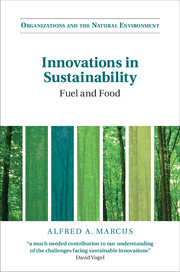Book contents
- Frontmatter
- Dedication
- Contents
- List of figure and tables
- Foreword
- Acknowledgments
- Introduction the path to sustainability
- Part I Funding sustainable startups
- Part II Business models
- Part III The macroenvironment and industry context
- Part IV Finding customers
- Part V Competition between mission and non-mission based businesses
- 9 Consensus capitalism: Whole Foods and Walmart
- 10 Sustainability's next frontier: DuPont and Monsanto
- Concluding observations: the journey continues
- Index
9 - Consensus capitalism: Whole Foods and Walmart
from Part V - Competition between mission and non-mission based businesses
Published online by Cambridge University Press: 05 August 2015
- Frontmatter
- Dedication
- Contents
- List of figure and tables
- Foreword
- Acknowledgments
- Introduction the path to sustainability
- Part I Funding sustainable startups
- Part II Business models
- Part III The macroenvironment and industry context
- Part IV Finding customers
- Part V Competition between mission and non-mission based businesses
- 9 Consensus capitalism: Whole Foods and Walmart
- 10 Sustainability's next frontier: DuPont and Monsanto
- Concluding observations: the journey continues
- Index
Summary
John Mackey, charismatic founder and long-time CEO of Whole Foods, referred to the business model that he followed as conscious capitalism. First and foremost this model meant that Whole Foods pursued a higher purpose than just maximizing the wealth of its shareholders. However, a better description of the kind of capitalism in which both Whole Foods and Walmart were engaged might be called consensus capitalism. All companies in the second decade of the twenty-first century had to profitably grow to please their shareholders and at the same time had to pursue a sustainability agenda that could convince external stakeholders of their rectitude.
The capitalism that both Whole Foods and Walmart practiced had converged, a convergence that signified that the major challenges that the two firms confronted were not entirely different. Whole Foods had to increase the size of its market while it continued to enhance its image as a company that was, to use Mackey's words, heroically trying to change the world. Walmart, as well, despite its immense size, had to meet shareholder expectations to grow and be profitable while at the same time it had to improve its reputation for corporate social responsibility, if not as heroically as Whole Foods, then by means of practical steps that had meaning for its workers, the environment, and communities.
No matter how much these companies had achieved they still had far to go on their journeys toward sustainability. They had to become more sustainable while also meeting the expectations of their shareholders. The dilemma they faced was how to deal with the challenge of achieving this broad agenda. What should their plan of action be? What should they do next?
- Type
- Chapter
- Information
- Innovations in SustainabilityFuel and Food, pp. 259 - 295Publisher: Cambridge University PressPrint publication year: 2015



